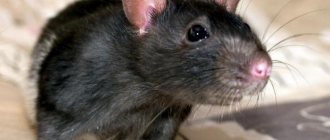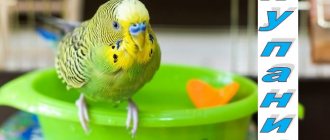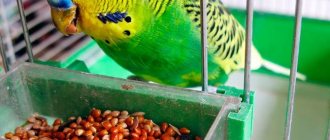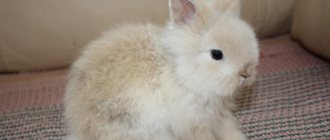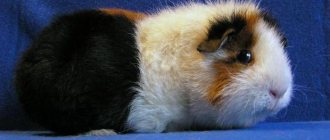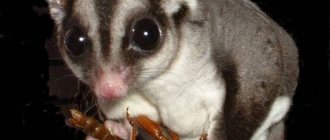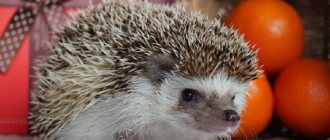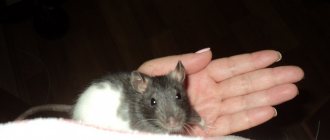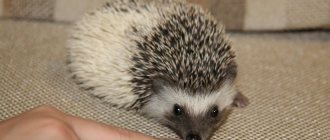Budgerigars are the most popular pets among all birds. They are loved for their love of life, cheerful disposition, high mental abilities, bright plumage and unpretentiousness to living conditions. They are found in families with small children, novice bird owners and single people. In this article you will learn everything about budgies, how they live in the wild and at home. How to buy the best feathered pet, how to care for it and what you can train it. You will find information about breeding these birds, their diseases and life expectancy.
You choose a budgie: where to start caring for the bird
At the first inspection, you need to pay attention to the fact that the chick is active. This can be determined by rapid springy movements, quick reactions, and a desire to interact with the outside world. He should have shiny eyes, smooth plumage that fits tightly to the body, light breathing without hoarseness and clean feathers in the anus.
Budgerigars have a variety of colors
It is also necessary to examine the beak, which should be smooth, dry, without secretions and foreign formations, the wax and paws, which should not show signs of peeling. The claws should not peel off. Caring for a budgie will be easier if you have information about the bird.
Boy and girl budgerigar
It is also important to make sure that the bird is young enough, this can be determined by the wax (in young birds it is always a delicate pale pink or bluish color), by the frontal feathers decorated with contrasting colored stripes (by 6-7 months of age these stripes are highlighted) , and in the eyes (in chicks they are uniformly dark, in adults a gray and later a white rim appears along the outer edge).
Budgerigar chick
If the sex of the bird matters for the purchase, since there is an opinion that males are more talkative, then the “boy” chick has a lilac cere (in an adult it is deep blue), the “girl” has blue, white, beige, (in an adult it is brownish ) around the nostril openings there are characteristic white rings.
Video: how to determine the sex of a budgerigar
If we talk in general about breeds of parrots, then the most popular, affordable and easy to keep will, of course, be the budgerigar, whose homeland is the grassy plains of Australia. Cockatiels and lovebirds are also quite popular.
Lovebirds
Corella is also an Australian, the smallest member of the cockatoo family, and lovebirds are native to Africa and Madagascar. Their small size makes it possible to keep these beauties in an ordinary apartment, in a fairly compact cage, without any problems. When choosing a larger bird (for example, a Gray), it is important to take into account that it needs a large, spacious cage or aviary.
Mating season
The male begins to actively court the female. He dances, nods his head, chirps and flaps his wings. If the female accepts courtship, she nods in response, cuddles and rubs with her beak. She can also take part in dancing.
If a couple has formed, then the male begins to take care of the female. He will clean her feathers and feed her. During the mating season, parrots' ceres become bright, rich in color due to hormones.
If a female or male reacts aggressively to each other and fights, they need to be seated. This indicates that the pair did not work out and there will be no mating. In this case, you need to choose another partner.
Features of feeding budgies
A budgerigar needs not only careful care, but also proper feeding.
The main components of the diet are as follows:
- greenery;
- cereals;
- fruits and vegetables;
- proteins.
Wavys need to be fed with greens.
The basis of the diet is grain feed. Nowadays there is a large selection of food for different types of birds on sale, so you can easily choose the one that suits your pet. You can supplement it with porridges (buckwheat, rice, millet). It is necessary to give your pet fresh greens:
- dandelion leaves;
- salad;
- dill;
- spinach;
- plantain;
- wild cereals;
- dried nettle.
Fruits and vegetables are also beneficial:
- banana;
- orange;
- apple;
- pear;
- pieces of zucchini or pumpkin;
- grated carrots;
- beet;
- turnip;
- berries.
Parrots eat pears.
Chopped eggs and stale white bread are suitable as protein foods. It must be remembered that your pet should always have a drinking bowl with fresh water, to which you can periodically add a few drops of lemon, orange or grapefruit juice.
Bathing
Budgerigars love water treatments very much. The maintenance and care of such pets will be complete if you purchase a special bathtub for bathing. You can use a plastic tray or plate for this purpose. The water level in the container should be only a few millimeters. When swimming, you must follow the basic rules:
- You cannot force a bird to bathe;
- the water temperature in the bath is about +25 °C, the air temperature is not lower than +20 °C;
- do not allow your parrot to drink dirty water from the bath;
- clean the bath immediately after the procedure.
Some parrots like to bathe in wet leaves. To do this, place plantain, dandelion or lettuce leaves in the bath. This will be great fun for your pet.
Keeping a budgerigar: criteria for choosing a cage
When buying a cage, it is important to understand that it is your parrot's home, so he should feel comfortable in it. Keeping budgies should begin with the choice of future “apartments”. Spacious and multi-tiered, with the ability to install perches, rings, toys, several feeders, a drinking bowl, a bathing container - an ideal choice, partly compensating for being kept in captivity.
It is also important that the cage is easy to use and made of durable material. A cage with metal bars would be the best option, since a wooden one has a risk of parasites and is guaranteed to absorb and stagnate a specific odor.
You should not place the cage too close to the window, as drafts may cause the bird to get sick.
It is advisable to structure the parrot’s keeping regime so that it has the opportunity to spend as much time as possible outside the cage, fly, move, and communicate. An insufficient number of flights will quickly affect your health, primarily on your respiratory function, which is directly related to the functioning of the wings.
How often should you clean your cage? The care and maintenance of budgies at home requires a number of rules. We need to start with cleanliness. As you know, cleanliness is the key to health. That is why cleaning should be done daily.
The cage needs to be cleaned regularly
If for some reason (departure, busyness, natural laziness) this does not work out, then you can add wood filler to the sand in the tray of the cage, as for a cat litter box, so that it absorbs the smell and moisture, but you should not abuse it.
It is necessary to clean the perches of droppings, pour boiling water over the drinking bowls, and remove husks and remaining food from the feeders. Sand and absorbent paper must be changed once a week. You should also disinfect the cage with a 1-2% solution of potassium permanganate.
Video: how to choose a cage for a budgie
The conclusions are as follows
You cannot keep a budgie:
- In the kitchen. There are always drafts, odors, harmful Teflon dishes and open fire.
- Near operating equipment: audio, video, TV, etc. Sharp and sudden loud sounds destroy the pet's nervous system.
- In the sun, whose direct rays are necessary, but you also need shade, where you can hide at any moment.
- The worst place is the window, where all the harmful effects are concentrated: drafts, heat, cold, unexpected flashes of light from car headlights, noise.
The best options for placing bird housing:
- Near the wall: press the back surface of the cage against the wall. This creates a place where the budgie feels safe. You can even hang it in the corner and thereby cover two sides of the house with walls. The bird will control the space even more confidently.
- On a human level. Communication requires convenience: if the cage is on the floor or suspended from the ceiling, communication will be reduced to zero. It is better that the budgerigar’s favorite roosting perch is at eye level with the household.
- In the common room: living room, dining room.
Conclusions on placing a cage with a parrot
Purchasing and arranging a cage
A little funny guy should be able to flutter and move freely in his own home. The more spacious it is, the better. The size 30x40x40 is barely enough for a single person. The material from which the cage is made can be any, but it is better to choose stainless steel. A proper home for a budgerigar should have thin, always horizontal rods, a flat bottom, and a retractable tray.
You can equip your home with two or three perches made from fruit trees. There is no need to paint them or remove the bark. Feeders are sold complete with the cage. There should be at least two of them: for dry food and wet food. Mineral supplements also need a separate container. You also need to purchase a drinking bowl, preferably an automatic one, and a bathing container. Recommended toys include bells, bells, swings, and a mirror, which wavy animals love very much. Igor Ignatenkov
Stocking up on food
To recover from debilitating molting, a special diet is required. To maintain good health, a parrot requires a balanced diet. The basis is:
- grain solid food - a mixture of various grains;
- soft supplements - protein foods, vegetables, fruits.
What to feed your parrot
You can mix the grain yourself:
- black, white, red, yellow millet – seventy;
- hemp, wheat, canary, flaxseed - twenty,
- oats - ten percent.
You can also buy a ready-made mixture. In addition, carbohydrates, proteins, minerals, and vitamins are needed, without which the body cannot function normally.
What can you give a parrot?
- Vegetables: beets, zucchini, cucumber, carrots, cauliflower, Brussels sprouts, broccoli and kohlrabi.
- Fruits: peaches, apples, pears, apricots (all pitted).
- Seasonal berries: strawberries, raspberries.
- Calcium and protein: hard-boiled egg.
- Zero fat cottage cheese.
- Herbs and wood: fresh leaves of dandelion, clover, plantain, young branches of rowan, linden, birch.
What should you give your parrot?
What's not allowed?
Store-bought expired cereal mixtures, human food (with salt, fried or fatty), bread, especially yeast bread, sweets. Breeders have different opinions regarding nuts. Some consider them too fatty and unhealthy, others recommend walnuts or peanuts. You probably just don't need to feed them often. Potatoes, eggplants, garlic, onions, radishes, avocados, mangoes, and persimmons are prohibited. Under no circumstances should you give branches of poisonous trees: poplar, acacia, lilac, oak.
Read also
The parrot crows and hides its head
Additional accessories
You will need swings, ladders, and a variety of toys. However, there is no need to overload the cage; space is more important for the wavy. Wickers and additional poles can be placed on the walls in the room.
Communication with a budgie is an important component of care and maintenance
In addition to the nuances discussed above, it is important not to forget about communication. After all, when purchasing a parrot, you want to get a friend or home decoration, so you should not reduce the care and maintenance of budgies to cleaning the cage. You need to devote time to the bird itself.
Parrot needs attention
The first rule is not to force yourself on the bird, give it the opportunity to get comfortable, to understand that it has everything it needs for a comfortable existence (including peace).
After your pet gets used to you and the new environment a little, you need to let him out of the cage. It makes sense to wear clothes made of thick, easy-to-clean fabric for these cases if you want to train your feathered friend to ride on your shoulder like a pirate, but don’t want to be scratched by claws or “marked.”
A budgie on your hand is an indicator of trust
The effectiveness of the learning and taming process of words and phrases will depend on many factors. For example, it depends on the breed, age, and whether the parrot is kept alone or in a pair (in this case, the birds are usually busy with each other). Grays, for example, are considered the most capable and susceptible to remembering human speech.
There is an opinion that the more often you repeat the same phrase or word, the faster the bird will remember and reproduce it. This is not true, but sometimes a pet can remember a phrase it has heard only once. Particularly talented ones can even convey entire dialogues and quotes from films verbatim, as well as imitate various sounds: car alarms, dog barking, mobile ringing, and even maintain some illusion of a conversation with the owner, which greatly amuses both owners and guests.
Video: how to teach a wavy to speak
Budgerigars are more predisposed to reproducing human speech; it is much more difficult to teach a cockatiel or lovebirds to speak. There is no point in turning the process into training, just talk to your winged counterpart every day, as you would with a family member, then the need to respond to you will come to the bird on its own.
Laying eggs
A week after mating, the female begins to lay eggs. Laying occurs 1 egg every 1 day.
The number of eggs in a clutch depends on the age and health of the female. Usually there are 4-7 eggs in a clutch. The maximum quantity can reach 12 pieces.
If the female has laid a large number of eggs, then there is a chance that she will not be able to warm them all and the eggs will harden. Then some of the eggs can be given to another couple with a smaller clutch, or an incubator can be used.
Some eggs may not be fertilized. How can this be determined?
- Unfertilized eggs take on a yellowish tint after a few days.
- Fertilized eggs become white-gray or porcelain.
Unfertilized eggs should not be removed from the house; they will serve as a heating pad. But it’s better to remove frozen eggs from the house yourself. Otherwise, the female may mistakenly throw away good eggs.
Budgerigar diseases and precautions
Keeping a parrot at home is a responsible task also because you need to monitor the pet’s health and understand how to care for it. To eliminate the possibility of drafts, so as not to chill the delicate tropical creature, install additional protective nets on the vents and windows to prevent accidental flight outside the apartment.
Mosquito net will protect parrots from flying out
Closely observe the behavior of the wavy. Lethargy, drowsiness, photophobia, and refusal to eat may indicate the onset of the disease. Some of the diseases, being infectious, can be transmitted to people. We are talking about diseases such as:
- Salmonellosis. It is difficult to detect; often the bird is only a carrier, a reservoir of the disease.
- Tuberculosis. It is characterized by deterioration of the plumage, the appearance of ulcers and enlarged lymph nodes. There is practically no treatment for birds.
- Arizonaosis. With arizonosis, anorexia, weakness, and tremors develop, but timely measures taken give a positive outcome.
- Chlamydia. Signs of chlamydia in parrots: diarrhea, cough, nasal discharge. It happens very quickly, often with a deadly ending.
Most of the listed diseases are transmitted by bacteria in the droppings, therefore, if infection is suspected, it would be useful to clean the cage wearing a protective mask and medical gloves.
Video: how to rid your budgie of ticks
The appearance of chicks
The incubation period lasts 16-20 days. Chicks are born every other day. At this time, it is especially important to maintain air humidity and avoid heat and dryness.
The thing is that under the shell there is a thin film that can dry out in the heat. In this case, the chick will not be able to break it and will die.
At birth, chicks weigh only 1-1.5 grams. They grow and develop quite quickly. If the clutch was large, then when the last chick appears, the first ones are already quite large and can crush the babies.
The chicks are born naked, blind and helpless. They are very weak, cannot support their heads and lie on their backs.
Breeding budgies at home
If your plans include increasing the population of flying pets, then this will require the creation of a number of conditions for reproduction. Breeding parrots in an apartment is not a difficult task, but it is troublesome.
The most difficult thing is to choose a pair and understand how to properly care for a budgie if it lives with a “family”. Breeders who have several individuals and, accordingly, room for choice, do this by observing the parrots in a large aviary.
If parrots mutually care for their plumage, treat each other, feed each other, and “kiss”, then they have every chance of having offspring. Then, if necessary, you need to artificially increase the daylight hours to 14-16 hours, equip the cage (preferably with two doors) with a “nest” - a house closed from prying eyes, where the female could calmly lay a clutch and hatch the chicks. Proper care and feeding of budgies is especially important during this period!
During this period, along with the usual grain mixture and juicy additives, they should be fed with sprouted grain, soft, easily digestible food. The quality of the masonry can be checked after a week using a flashlight or an ovoscope. If the female has settled stably on the eggs, and the male has taken care of her, there is hope that the pair has taken off.
When partners quarrel, the mother often leaves the nest, abandoning the clutch to the mercy of fate, or deliberately breaks the shell (which happens with young, inexperienced birds), it makes sense to replace one of the parents. By observing all the criteria for proper maintenance, it is quite possible to get beautiful, colorful, healthy offspring from your couple.
Video: breeding budgies
Life in the wild, habitats
In the country of budgerigars - Australia, these nimble creatures can be found everywhere: in eucalyptus thickets, savannas, meadows and forests. They only avoid the dense forests of the northern territories of the mainland.
They prefer to gather in flocks, which can number 30 individuals, or maybe several hundred. From eyewitness reviews: there are huge flocks of 20,000 budgerigars. Birds fly, chirping loudly and noisily flapping their wings.
Budgerigars are very fast in flight and can reach speeds of up to 120 km/h. No species of parrot can compare with budgerigars in speed. Such a rapid flight, as well as the synchronization of movements, often save birds from attacks by predators.
When a flock flies, it seems that a school of fish is swimming across the sky or a swarm of bees is moving - the birds have such a coordinated flight.
Thanks to their green, grassy color, small budgies hide well in the foliage. They feed on seeds of wild grasses, stems, and berries.
Under natural conditions, budgerigars can breed year-round if they have enough food and water. In the drier regions of Australia, their mating season begins after the end of the rainy season, when all the vegetation of the continent blooms wildly under the hot rays of the sun.
Nests are made in tree hollows. In a nest, the female can lay 4-12 white eggs. She incubates them herself, while the male brings her food throughout the entire period. Incubation lasts 20 days. The hatched chicks are blind and naked. After about a month, they are almost fully fledged and begin to leave the nest.
Air temperature and humidity: comfortable conditions for keeping a budgie
Many parrots tolerate a decrease in temperature for a short time normally. Despite this, you should not allow the bird to stay in a cold room for a long time or expose it to noticeable changes in degrees.
Temperature is very important for the wavy
The recommended temperature for optimal keeping of parrots is from 18 to 20 C. Under these conditions, a favorable atmosphere is created for full life activity, but during breeding it should be lowered by 2-3 units.
A successful pair of budgies
Temperatures should not be allowed to exceed the established norm, as this can lead to a deterioration in the bird’s well-being, decreased appetite and impaired reproductive function. It is known that when the temperature regime is violated, a large percentage of unfertilized eggs is observed. Lower temperatures have a positive effect on the processes of reproduction and fertilization. The level of air humidity should also be given sufficient attention.
For the room in which the bird is located, the humidity should be in the range of 70-80%. The temperature is kept at 15-20 C.
Control of humidity levels is necessary when temperature changes. High humidity can cause hypothermia in a parrot.
Owner reviews
Almost all owners are satisfied with their choice, as evidenced by them. At the same time, they note the fact that they are much calmer in relation to other species and are not so aggressive, since they do not use their beak so often.
The main problem is organizing proper and varied nutrition, since they cannot be fed with grain alone. Monotonous food leads to inflamed intestines. Cabbage should also not be given, since it also causes an inflammatory process, with enteritis and diarrhea.
Many owners note that parrots are omnivores, but new foods should be gradually introduced into the diet. It is very important to protect your pets from drafts.
Why do unfertilized eggs appear?
Usually in one clutch there are always about two unfertilized eggs or even frozen embryos appear. Inexperienced females often warm their testicles unevenly, which leads to slow development.
But if all the offspring die, then this indicates some genetic abnormalities or defects. Often the cause is infectious diseases that the parents have, so you will have to contact a veterinarian.
Unfertilized eggs or frozen embryos often result from the following reasons:
- birds represented by close relatives interbreed;
- the owner does not provide the birds with optimal nutrition;
- poor quality water is offered;
- parents are genetically incompatible with each other;
- incorrect humidity or temperature in the room;
- The bird is too small to hatch.
Eggs will not be fertilized if the breeder has not properly prepared the parrots. But sometimes this indicates the presence of health problems, and this is usually associated with the male.
Fertilization is even affected by the correct location and number of perches inside the cell.
